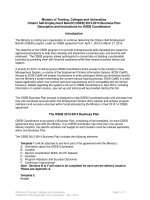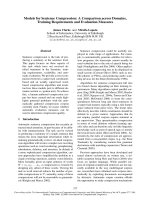Coaching skills Training Users and Customers
Bạn đang xem bản rút gọn của tài liệu. Xem và tải ngay bản đầy đủ của tài liệu tại đây (460.08 KB, 27 trang )
PNV
Professional Life
Coaching skills
Training Users and Customers
2011
Agenda
•
OBJECTIVES OF THE SESSION
•
HOW TO PREPARE A TRAINING
•
HOW TO TRAIN USERS AND CUSTOMERS
•
ROLE GAME
Copyright © 2007 - CIST
2
Agenda
•
OBJECTIVES OF THE SESSION
•
HOW TO PREPARE A TRAINING
•
HOW TO TRAIN USERS AND CUSTOMERS
•
ROLE GAME
Copyright © 2007 - CIST
3
Objectives
• The objectives of the sessions
are :
– To understand which kind of “trainings” you may have to do in your
future internship/job.
– To be able to prepare and conduct a client-oriented “training”.
– To be able to have a client-oriented approach as an :
IT technician towards other employees,
IT seller towards customers,
IT support member towards customers and other employees
Copyright © 2007 - CIST
4
Agenda
•
OBJECTIVES OF THE SESSION
•
HOW TO PREPARE A TRAINING
•
HOW TO TRAIN USERS AND CUSTOMERS
•
ROLE GAME
Copyright © 2007 - CIST
5
Training Situation
• Definitions :
– A training situation is everytime you need to explain something
(technical) to an IT user or an IT customer.
– Examples :
Formal training session,
One-to-one explanation of an IT procedure or a user guide,
Explanation of what you are doing on a IT user / customer PC
(when solving a problem or installing a software for instance),
Recommendations made to an IT user / customer on how to use
their PC and/or an applications/tools,
Explanation about the IT services you provide to a client.
– Your Own Examples : Client may ask…
Copyright © 2007 - CIST
6
Preparation(1/2)
• Before doing a training or explaining something, what do
you have to ask yourself? :
Copyright © 2007 - CIST
7
Preparation(2/2)
Who
needs to receive the message?
What
needs to be communicated?
When
should the message be delivered?
How
Copyright © 2007 - CIST
best to communicate the message?
8
Preparation (Who) 1/2
Who needs to receive the message?
• Identify your target audience, their needs and level of IT
knowledge :
– Depending on the number of people : one-to-one training or IT
explanation? Or in front of several people?
– Is the audience made from IT staff (customer or internal), or only IT
users from your company?
Copyright © 2007 - CIST
You will avoid too technical words for users or customers who are not familiar
at all with the topic:
9
Preparation (Who) 2/2
-If the user/customer is not expecting your visit, you’ll have to explain
him before, why you are here and check if he/she is available:
« Your manager asked me to install this software on each PC in this
room. It will only take 15 minutes. Are you available right now? ....
Let me first explain you what is this software...»
Have a « client-oriented » approach
Copyright © 2007 - CIST
10
Preparation (What)
What needs to be communicated?
• Clearly define the scope of your training / IT explanation:
– Identify the objectives of the training/explanations.
– If needed, have these objectives confirmed/validated by your
manager.
– Don’t plan to present something that is not linked with these
objectives :
Don’t confuse your audience with non useful information.
– Check if what you’ve planned to present is reaching all the objectives
you identified.
Copyright © 2007 - CIST
11
Preparation (When)
When should the message be delivered?
• Identify the level of urgency of the training / IT explanation :
– Urgent : problem solving/troubleshooting, urgent installation...
– Not urgent : planned installation or update, explanation of IT concepts or
procedures...
• Define the time allocated to your training / IT explanation :
– Do you have an allocated time?
Example : you are asked by your manager to make a 2 hours training on the use of
the network administration tool for new hired IT staff in the company.
– If not, according to the audience and the topic you have to cover,
estimate the time you will need and check if the user/customer will be
available during this lentgh of time.
Copyright © 2007 - CIST
12
Preparation (How)
How best to communicate the message?
• Based on the answers to the 3 previous questions, decide
how you will do your training or deliver your IT
explanations to the user / customer :
– Based on paper documentation (powerpoint presentation, IT
procedure...)?
– Only oral training / explanation?
– At the user / customer desk?
– In a dedicated training room ?
– ...
Copyright © 2007 - CIST
13
Preparation Tips
• You may not have all the answers to these questions...
Ask your manager and/or
colleagues for more information !!
Copyright © 2007 - CIST
14
Exercise: Preparation
• For each of the following situations answer the 4
questions (Who, What, When and How) :
Who
level of knowledge of the user?
does the user expect your training
or not?
The Director of
your company
doesn’t know how
What
scope of your training/
When
urgent or non-urgent intervention?
estimation of the lentgh of the
to sort the data of
a sales reporting
file (Excel) by date.
training/explanation?
Your manager asks
you to explain
him/her how to do
that.
Copyright © 2007 - CIST
explanations?
How
use of documentation?
explanation/training at the desk of
the user? Or in a dedicated room?
15
Exercise: Preparation
• For each of the following situations answer the 4
questions (Who, What, When and How) :
A new e-mail tool
Who
or not?
(Outlook) will be
implemented in
your company in 1
level of knowledge of the user?
does the user expect your training
What
scope of your training/
When
urgent or non-urgent intervention?
estimation of the lentgh of the
explanations?
month. Your
manager asks you
to train the
training/explanation?
employees of the
HR department (5
people) on this new
tool.
Copyright © 2007 - CIST
How
use of documentation?
explanation/training at the desk of
the user? Or in a dedicated room?
16
General Training Tips
– Customer = Client : individuals or companies which may buy a product
(service and/or goods) from your company
– Client oriented approach or customer orientation:
the set of beliefs that says that customer needs and satisfaction
are the priority of an organization.
Customer orientation places an emphasis on listening to
customers, assess their needs and deliver the best value or best
services.
Copyright © 2007 - CIST
17
Agenda
•
OBJECTIVES OF THE SESSION
•
HOW TO PREPARE A TRAINING
•
HOW TO TRAIN USERS AND CUSTOMERS
•
ROLE GAME
Copyright © 2007 - CIST
18
Training Tips: Apply Communication
Skills (1/3)
– Facilitate the understanding of your message:
Plan, organize, and structure your communication (Introduction,
body, and conclusion)
Use simple, concise, and factual words or phrases to say and
explain,
Avoid using too many jargons or too long and complex sentences,
Make sure that the information is not too long and not too short
(lack of information)
Make sure that the receiver understands what you are saying:
You spend more time on complicated points and use more than one way to
explain,
You can ask your listeners if they see your points,
You can repeat or debrief what have been said at the end of talk.
Copyright © 2007 - CIST
19
Training Tips: Apply Communication
Skills (2/3)
• Choose the appropriate form of
communication:
– Verbal and nonverbal communication: depend on the message you
want to convey
– Oral or written communication: think of the most effective medium
• Be flexible:
– Make sure that the words and attitude used fits with the receiver
status or position.
Formal or informal communication: depends on the receiver
– Choose appropriate time for your talk.
Copyright © 2007 - CIST
20
Training Tips: Apply Communication
Skills (3/3)
• Develop your speaking skills:
– Do not speak too fast or too slow,
– Be careful with the volume of your voice (do not shout, and do not
murmur).
• Use nonverbal communication to improve your oral
communication skills:
– Keep eye-contact to the whole audience,
– Smile to the audience,
– Be careful with your posture:
Sit or stand erectly,
If you sit, do not sit with cross legs,
Avoid putting your hand (s) in your pocket, cross your arms or put your hands behind
you back.
– Dress appropriately,
– Avoid moving too much, because it can make the audience feel dizzy
or bored,
– Be polite.
Copyright © 2007 - CIST
21
Agenda
•
OBJECTIVES OF THE SESSION
•
HOW TO PREPARE A TRAINING
•
HOW TO TRAIN USERS AND CUSTOMERS
•
ROLE GAME
Copyright © 2007 - CIST
22
Role Game Instruction
• Organizing the groups
–
Keep the groups organized during the “IT Procedure” module
–
2 members of each group switch with 2 members of another group.
• Role game
–
1 trainer, 1 trainee, 2 observers
–
Each student explain one procedure to the members of the other
group.
–
Observers make an assessment and communicate the comments to
the other team members.
–
After students exchange their roles: the 2 observers are becoming
trainer and trainee.
1h10m
n
Copyright © 2007 - CIST
23
Role Game
• What are the comments made?
• What have been improved
between the first and the
second round of the role game?
• What can still be improved?
Any questions?









